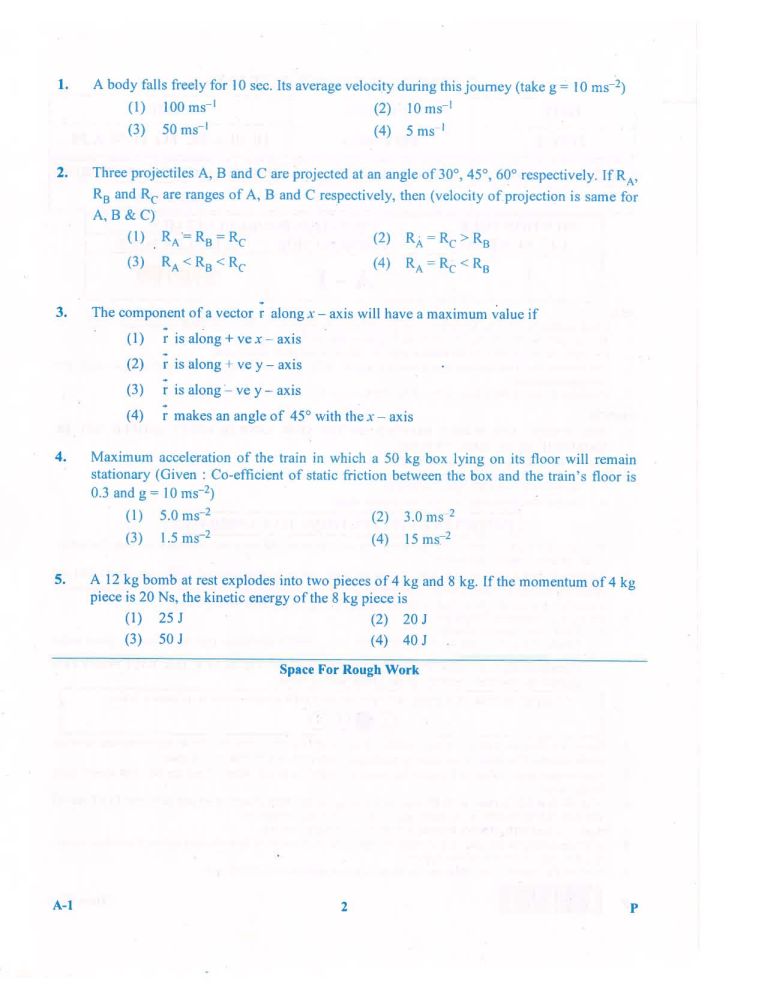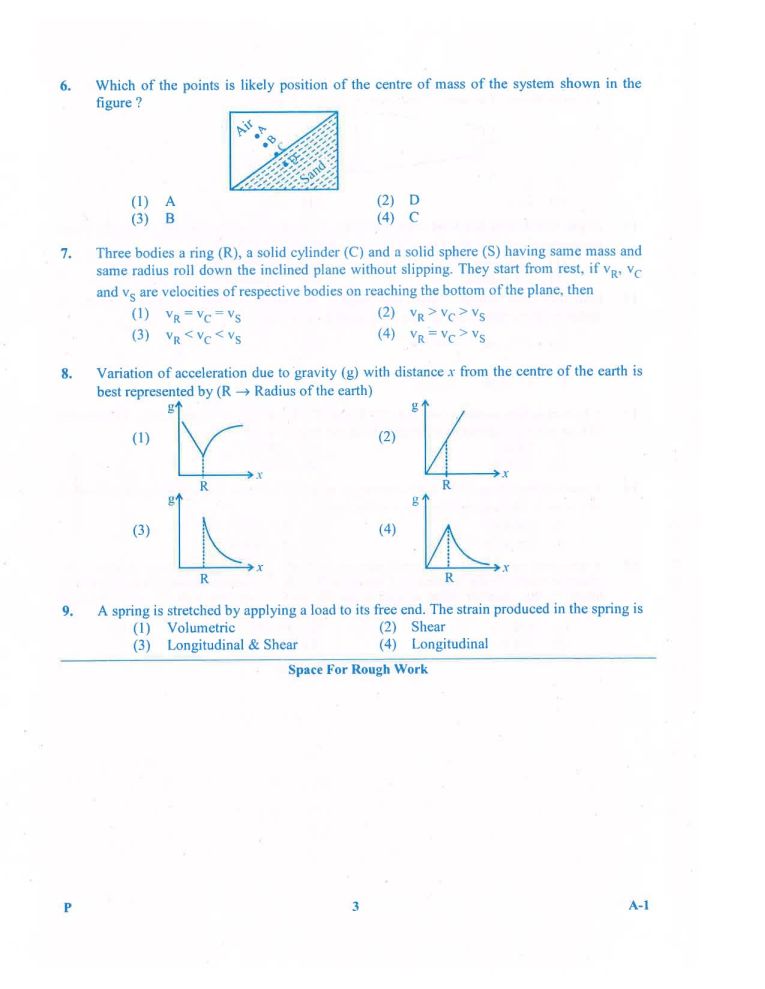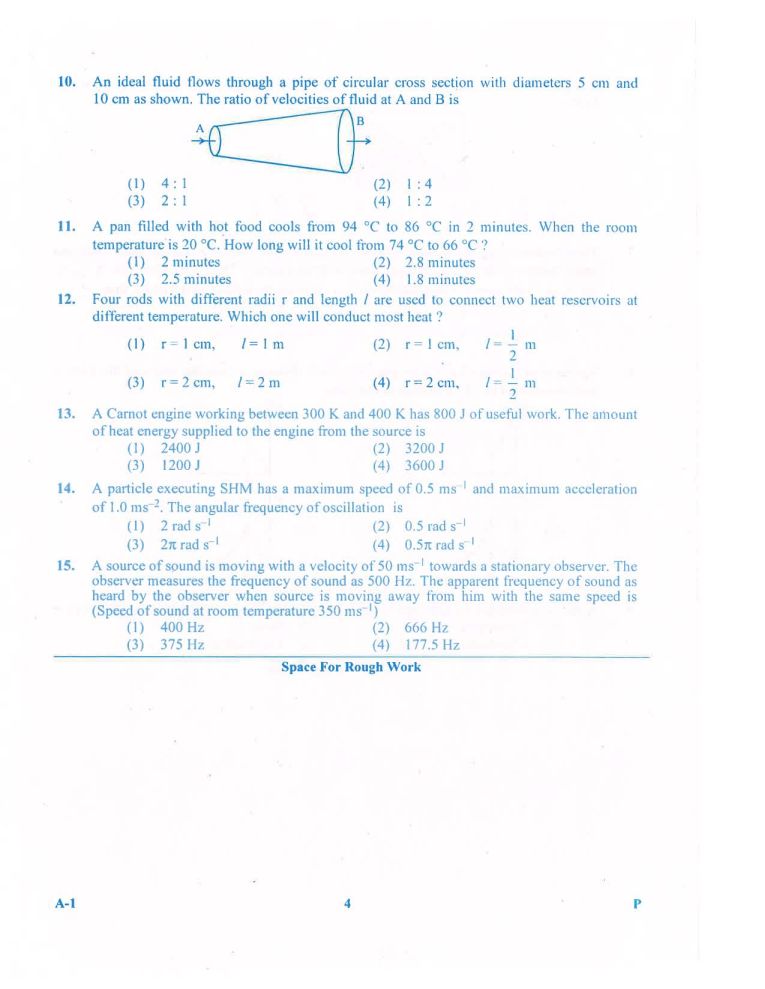|
#3
22nd May 2018, 04:28 PM
| |||
| |||
| Re: NERIST Question Paper
As you want here I am giving below NERIST Entrance Exam question paper on your demand : NERIST Entrance Exam question paper     Syllabus NEE I Physics Measurement in Science and Technology: Measurements and measurement systems; Historical developments in measurement science; the modern measurement system; The international system of units (SI); Maintenance of standards of measurements; Multiples and fractions; Indian national standards of measurements. Structure of Atom: Fundamental Experiments and discharge tube and the discovery of the electron; Canal rays or positive rays; X-rays and radioactivity; Atomic nucleus; Structure of atom; Discovery of the neutron; Atomic Number and atomic mass; isotopes. Motion: Motion of living and non-living objects; Distance and displacement; Uniform and Non Uniform motion, Velocity; Non uniform motion and acceleration; Graphs and their uses; Uniform circular motion. Gravitation: Universal law of gravitation; Motion of particles under gravity; Motion of a projectile, Mass and weight; Geotropism. Work, Energy and Power: Work, work done when the force is not along the direction of motion; Energy; Power, Transformation of energy, Conservation of energy. Heat: Heat and temperature; Thermal equilibrium; Mercury thermometer, Heat as a form of energy, Effects of Heat; Changes of state. Wave motion and sound: Simple Pendulum, Wave motion; Transverse and longitudinal waves; Graphical representation of simple harmonic waves characteristic of harmonic waves; Relation between wave velocity, frequency and wave length for a periodic ; Nature and propagation of sound; speed of sound; Range of hearing in humans, Reflection of sound, practical applications of reflected sound; Echoes; Sonar and Application of Ultrasound. Light reflection and refraction: Nature of light; reflection of light by mirrors-by plane mirror, spherical mirrors, new Cartesian sign convention for reflection by spherical mirrors and derivation of mirror formula, magnification; Refraction of light-the refractive Index, reflection through a rectangular glass slab, refraction by spherical lenses, sign convention with spherical lenses - Lens formula, power of a lens, total internal reflection, some optical phenomena in nature; dispersion of white light by a glass prism; color of objects-primary colours of light and pigments. Optical Instruments: The human eye; defects of vision and their correction; microscope and the astronomical telescope. Electricity, its heating and chemical effects: Electric charges and its properties; conductors and Insulators; electric current-charges in motion; electric potential and potential difference; circuit diagram; Ohms law-resistance, resistivity, resistors in series and in parallel; heating effect of electric current-electric energy and electric power. Magnetic effects of electric current: Magnetic field and field lines; magnetic field around a current carrying straight conductor; force on a current-carrying conductor in a magnetic field; electric motors; electromagnetic induction; electric generators; domestic electric circuits; the electric fuse-A safety device. Nuclear Fission and Fusion: Nuclear reactions; Nuclear fission; Fission products; Energy released in fission reactions; Chain reaction; Theory of Nuclear fission; Nuclear reactors; Nuclear hazards and safety measures. The Universe: The solar system- the sun, the terrestrial planets, the Jovian planets, asteroids, meteorites and comets. The Structure and evolution of the earth; the stars and constellations; Milky way galaxy and other galaxies; Space exploration-Space Programme in India. Chemistry Matter around Us: Physical nature of matter, states of matter; General concept about mixture, solution, colloidal solution, suspension, distillation, condensation, evaporation, sublimation and fusion; Effect of pressure and temperature on states of matter. Atomic Structure: Daltons atomic theory, elements, compounds, cathode ray, X-ray, Thomson’s model of an atom, Rutherford’s model of atomic structure. Bohr’s model of atomic structure. Electronic configuration (in terms of Shells only) of elements up to Atomic No. 20; Atomic number, Mass number, Isotopes and Isobars; Radioactivity. Classification of Elements: Mendeleev and Modern periodic table, Periodic trend of metallic and nonmetallic character, atomic size, nature of bonding, oxides and related chemical properties, prediction of properties of an atom. Chemical Bonding: Octet rule or inert gas configuration as criteria of stability. Ion, atom and valency. Ionic bonds, covalent bonds (in simple cases), shape of Molecules of H2O NH3, CH4 CC14, C2H2, C2H4 SF6, PCI5, CO2 BeCl2 BF3. Chemical reactions and some basic concepts: Decomposition, Displacement reactions, Isomerization, Combination, Reversible and Irreversible reactions, Chemical equilibrium, Law of chemical equilibrium, chemical formula and equations, Atomic and Molecular masses, Mole concept, gram atomic mass and gram molecular mass, Mole concept, gram atomic mass and gram molecular mass, Determination of formula of unknown compounds, Balancing of chemical reactions. Energetics: Bond energy, Energy involved in a reaction. Photo-chemical reactions and generation of free radicals. Electrolysis of water and NaC1, Electrochemical cells (Galvanic cell) with reference to dry cells and storage cells. Sun and Nuclear energy, Sun and its source of energy (Nuclear fusion), Nuclear fission, Chain reaction, Nuclear reactors, Nuclear hazards, simple nuclear reactions. Metals: Physical and chemical properties, Reaction with O2, dilute acid, C12. Elementary metallurgy of Cu, Fe, Al, and uses of the metals. Washing soda, Baking soda, lime, preparation of Bleaching Powder, Plaster of Paris, Cement, Glass, Steel. Some common alloys of copper, iron and aluminum. Corrosion of metals. Non-Metals: Physical and chemical properties, reactions with O2, acid, C12, H2, Preparation and properties of Si, P, S, ammonia, hydrogen and sulphuric acid. Carbon and its compounds: Allotropes of carbon. Hydrocarbon: Alkanes, Isomerism in alkanes. Petroleum; Preparation and properties of Methanol, Ethanol, Methanal, Propanone, General properties of organic acids and esters, Synthetic polymers: addition polymers (PE, PP, PVC, Teflon) and condensation polymers (nylons and polyesters); Rubber and its vulcanization; Soaps, detergents; Cleansing action of soaps and detergents. Bio-mass as fuel: Fossil fuel, Coal, Petroleum, Natural gas; Classification of Fuels. Calorific value of fuels, Ignition temperature, Combustion of fuels, Characteristics of an ideal fuel. Environmental Pollution: Types of pollution and pollutants, Acid rain, Green House Effect, Eutrophication and Soil erosion. Conservation and protection of environment. |